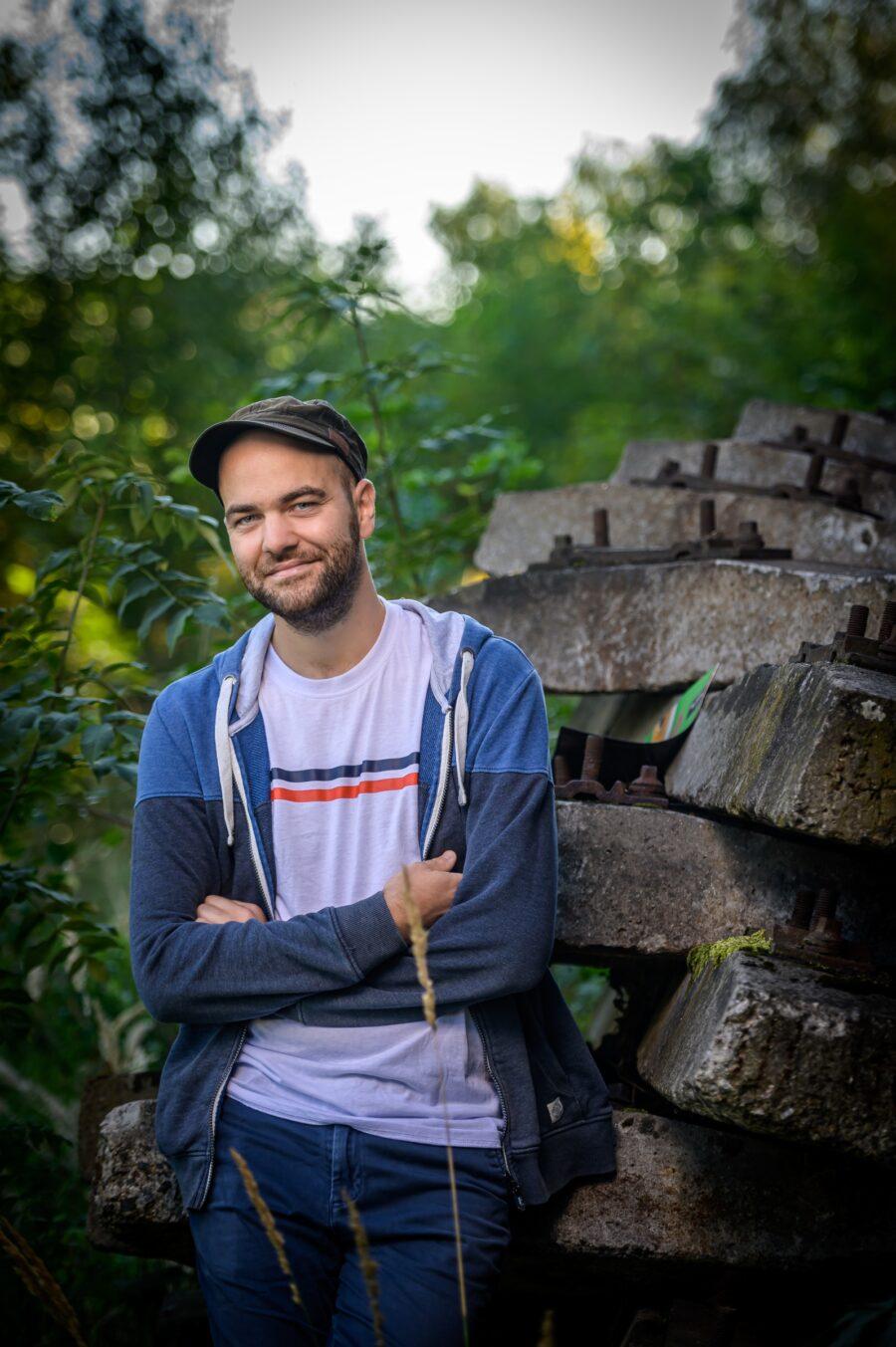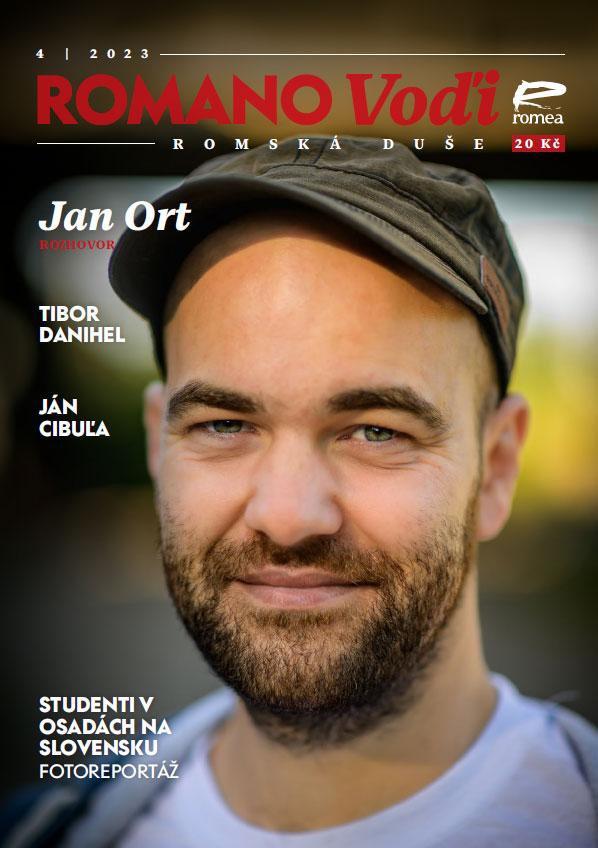Award-winning scholar Jan Ort for Romano voďi: Anti-Roma racism is still being minimized

Jan Ort (32) is a graduate in Romani Studies from Charles University's Department of Central European Studies at the Faculty of Arts in Prague, Czech Republic and is completing his doctorate in the historical sciences. Recently he became the first recipient of a new award from his alma mater, the Charles University Faculty of Arts Award, for a monograph entitled Facets of a Harmony: The Roma and Their Locatedness in Eastern Slovakia.
Q: How did you make your way to Prague’s Romani Studies program?
A: When I was in college prep school we had a relatively enlightened history teacher who focused one of his classes on Romani people as a subject. There was a discussion and my fellow students and I continued it into the break. They were expressing their opinions about the Roma in a rather indiscriminate way. I did my best to defend the Roma, intuitively, to refute the various prejudices and stereotypes the others were repeating, but I quickly ascertained that I basically had no argument of my own to make because I simply did not know anything about Romani people. In the moment, that really irritated me. However, In class we had also heard that there is a field of study at university about the Roma, so I applied to Romani Studies and I devoured all I could during my preparations for the entrance examination.
Q: You read the recommended literature…
A: Exactly, I read Elena Lacková’s Narodila jsem se pod šťastnou hvězdou [Published in English as: A False Dawn. My Life as a Gypsy Woman in Slovakia] and I felt that this was an absolutely new space for me in which there was still room for exploration. Immediately from the outset I also had to correct my own distorted imaginings: Originally I believed I would be studying something like social work targeting Romani people. Thanks to my fellow Romani students, both men and women, I comprehended rather quickly that Romani people were involved in Romani Studies not just as objects of interest or as the recipients of aid. I realized that Romani Studies is a full-fledged field of scholarship, just like Czech Studies or German Studies, aiming for comprehensive knowledge about the Roma, all the while emphasizing the perspective of Romani people themselves. However, at the same time that does not mean the reality of Romani people’s position in society is ignored during the instruction.
Q: How can the perspective of a Romani Studies scholar be valuable when it comes to certain subjects?
A: What is crucial is that Romani Studies scholars are interested primarily in the perspective of the Roma themselves, which is decidedly not the rule in general, and not just when it comes to research, but also to the broader discussion about the Roma in society. If, for example, the authorities’ perspectives are what is frequently discussed and followed when it comes to policies targeting Roma, the Romani Studies scholar will view those policies primarily from the standpoint of the experiences and interests of Romani people themselves. Romani Studies is a field that is limited in terms of its subject matter, but not limited in terms of the disciplines through which knowledge of this theme (i.e., about Romani people), can be discovered, it combines different scholarly disciplines, e.g., anthropology, history, linguistics, etc. What is important is that these disciplines are not expected to function separately, rather, they augment each other to create a comprehensive image of the Roma as a diverse group of inhabitants connected by a common experience.

Q: What role does the Romanes language play in all of this?
A: In addition to the Prague Romani Studies program cultivating a certain interdisciplinarity, which stems from the way it was established and then led by Milena Hübschmannová, it emphasizes knowledge of the Romanes language in particular. It is expected of Romani Studies students and scholars that they will use Romanes as a tool for exploration (understandably with the awareness that not all Romani people speak Romanes). Besides the fact that, thanks to knowing the language, one can comprehend not just this or that communication, but also many aspects of the culture of the Roma (understood in a wider sense) which would otherwise remain concealed, there is also an important level of symbolism to speaking it. The interest in intensifying one’s knowledge of Romanes can lead a person from outside a community, especially a non-Romani person like me, to establish an absolutely different kind of relationship with Romanes speakers. On the one hand, this demonstrates one’s deeper interest in the lives of Romani people, and on the other hand it can also counterbalance what is otherwise an unequal relationship between “researcher” and “research subject”, as it is partially reworked into a relationship between a language student and a language teacher.
Q: You tried that out directly in practice – after completing your state examinations for your bachelor’s degree, you went to eastern Slovakia for 10 months. Where did you go and why?
A: I got the opportunity to receive a scholarship for a study stay in Prešov, Slovakia at the university there. The content was field research in a small village in northeast Slovakia. I enjoyed Romani Studies and as part of the program I had begun to lean toward cultural anthropology as a discipline. However, what I wanted to draw from was not just the literature, but deeper experience from the “field”, to acquire my knowledge from Romani people themselves. They led us in that direction at Romani Studies and I already had some experience of that kind from my bachelor’s studies. However, this was a brilliant opportunity for more intensive, long-term research, and anthropology also assumes such an approach.
Q: How did you choose the selected village?
A: I intentionally selected a village that was relatively small so I could encompass its internal relations in all their complexity. At the time there was a total of about 150 inhabitants living in the village, half were Romani and the other half were mostly Ruthenians (but in their own way, the Roma there also considered themselves to be Ruthenians as well). The village had been publicized with the reputation of being a community where coexistence between non-Roma and Romani people works. It had been lifted up as unique in that regard. I was irritated by this story of “coexistence that works” because it was based on assumptions of “coexistence that is problematic” with Romani people and reproduced those assumptions. I wanted to see the reality of the interethnic relations being described for myself, up close, and to follow their everyday aspects.

Q: You describe what you observed in the introduction to your monograph. The book has also been published in English and you received an award for it. How do those relationships work?
A: One of the main theses of the book is that the coexistence described, its harmony, which I somewhat provocatively put into the book’s Czech title, does not represent an equal relationship between two distinct cultures in some sort of ideal multiculturalism. It is based on the shared acceptance of historically-shaped, perpetually-conserved social structures in which Romani people, compared to their non-Romani neighbors, are naturally associated with the lower rungs of society, irrespective of what they do or how they behave as individuals. I chose the title Facets of a Harmony [in Czech, “Harmony of Coexistence” – Harmonie soužití] a bit provocatively because in the book, I gradually deconstruct that harmony. At the same time, though, I did not want to say, through the book, that a coexistence that is harmonious does not exist there in reality, I didn’t want to ignore the experience of the individual people who spoke about it. Rather, I wanted to demonstrate the foundations on which it stands, what it involves and what its limits are. The Romani people themselves also described those foundations, after all, when they eventually also named their experiences of being in that subordinate societal position.
The book basically critiques the concept of integration, it says that in the places where it apparently functions, where Romani people have managed to “adapt” – and now I am intentionally using the dominant language here – then it is always at the price of reproducing structures that are unequal, perpetuating racism. This does not have to be about discrimination that is openly racist, but about deeper, more difficult to capture forms of exclusion of the designated group of inhabitants into an inferior position in society on the basis of their language, their skin color, their surnames, etc. Because they are harder to capture, that of course makes them difficult to name and do something about. The problem is that while conflict that is open could have an emancipatory potential and can change the established order of things, an emphasis on harmony, to return to that concept, just smooths everything over and preserves positions that are unequal.
If I expand this beyond the community whom I followed, then for the dignified position of Romani people in society, emphasis should not primarily be placed on their becoming educated and achieving a certain mobility, socioeconomically, but above all on society no longer imposing the conditions which Romani people have to fulfill to be accepted. It is necessary to accept Romani people as equal human beings unconditionally, and that will never be achieved through an emphasis on “harmonious coexistence” with “integrated” Roma.
I perceive an important aspect of this book to ultimately be its emphasis on agency among the Roma, the Romani people do not appear as defenseless, passive victims of power structures in society, but they have their own tools – albeit frequently of limited reach – for undermining these structures, for fighting for a dignified place in society, or for laughing at their non-Romani neighbors a bit, in short.
Q: This fall you will defend your dissertation, and next year it will again be published as a book. What is its subject?
A: In my dissertation, I have focused on Czechoslovak policy toward Roma during socialism in the 1960s, specifically I was most interested in the policy known under the term of “dispersion”. This was about the relocation of Romani people within Czechoslovakia for the purpose of controlling them more easily and assimilating them overall into non-Roma society. That policy has already been mentioned a great deal in the literature to date and has been perceived as one of the main symbols of the Czechoslovak communist regime’s violence toward Romani people, it is said to have led to the breakdown of the cultural identity of Romani people and of the networks of their socioeconomic solidarity.

Q: Viewed from the Romani perspective, it was apparently more complex than that…
A: Yes, paradoxically, insight into these processes has come almost exclusively from the authorities’ perspectives, very little about this policy of relocation has been described from the perspective of the experiences and interests of the Roma themselves. I concentrated, therefore, on the perspective of Romani people, I did my best to reconstruct the impact on their lives of this policy of relocation in practice. I am “hacking” this story about the communist regime’s violence against Roma, I demonstrate that a great deal of what was emphasized by the policy in those days overlapped with the interests of Romani people themselves. In eastern Slovakia, the elimination of settlements through the efforts of many Roma to move away from them is one example. Likewise, relocating into Czechia, in many cases, connected with the migration Romani people were already undertaking on their own as an economic strategy. Moreover, Roma themselves were able to move central policy praxis even closer to their own interests, many of them eventually even became local assembly members and bureaucrats at different levels of the state apparatus and also spoke about specific policies. I am observing Romani people, therefore, not as a group that is homogenous, as inhabitants whom it its apparently natural to separate from the rest of the society and who await the impact of state policy, but as an integral part of society, occupying various positions in it and contributing to the negotiation of policies and their practices.
Q: When we view this from the perspective of today, what do we see?
A: There is a tendency here to view communist policy toward the Roma in terms of symbolic violence. However, for example, the “dispersion” policy in the 1960s, while it was formulated sometimes through insane language and frequently motivated by fear of a growth in the population of inhabitants who would not conform to society, and while it was discriminatory in many respects because it did essentially limit the constitutionally-guaranteed freedom of movement of a certain group if inhabitants, from today’s perspective, it was unprecedented, in that it attempted to better the conditions of this historically marginalized group of inhabitants systematically through special budgetary allocations and a campaign to eliminate “anti-gypsy attitudes” in society. To pay such attention, from the Government’s position, to the attempt to improve the living conditions of the Roma is politically untenable today, it’s unthinkable.
Q: It’s politically unpopular.
A: Yes, most politicians, in my opinion, appear to be latent racists who, at the right moment, make some comment about how it would be better if the Roma “got to work” here. Racism, in my view, is undeniably the main cause of the dismal living conditions of many Romani people in the Czech Republic and Slovakia, too. Racism is minimized, and again and again the responsibility for their situation is transferred to the Roma themselves. This was demonstrated quite well with the refugees and the selective solidarity with those coming from Ukraine, including at the level of the policies of the state and its offices. I believe we have to hold a discussion about anti-Roma racism in all its complexity. We shouldn’t just use racism as a term of abuse that excludes matters from discussion, but we should discuss it more analytically: What are the different aspects and forms of racism? In which different situations in society does it show up, and how? Those are the important matters, not the education of the Roma, although I decidedly do not want to take anything away from the emphasis on their equal access to education, rather the opposite.
Integration is still spoken of in the public space, but I would invert the perspective. Romani people are perceived as a priori standing outside society, and the claim is that they have to be integrated, i.e., in the spirit of the frequently-heard position that “they came here X centuries ago and they still don’t manage to adapt”. However, it is high time to say that people are here who are a full-fledged part of our society and who are being excluded from it because they are Romani, sometimes. Let’s switch our attention to the mechanisms of segregation in society and acknowledge the full, unconditional belonging of Romani people to this society.
This interview was first published in Czech in Romano voďi magazine.
